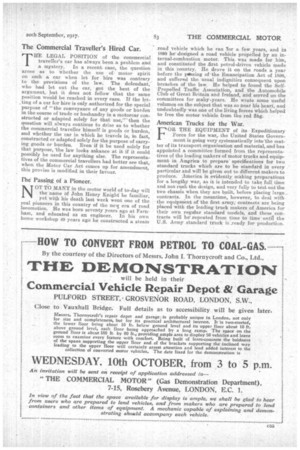The Commercial Traveller's Hired Car.
Page 19

If you've noticed an error in this article please click here to report it so we can fix it.
THE LEG-AL POSITION of the commercial traveller's car has always been a problem and a mystery. In a recent case, the question arose as to whether the use of motor spirit on such a car when let for hire was contrary to the provisions of the law. The defendant,who had let out the ear, got the best of the argument, but it does not follow that the same position would be reached in every ease. If the let . . ting of a ear for hire is only authorized for the special purpose of "the conveyance of any goods or burden in the course of trade or husbandry in a, motorcar constructed or adapted solely for that use," then the question will always continue to 4rise as to whether the commercial traveller himself is goods or burden, and whether the car in which he travels is, in fact, constructed or adapted solely for the purpose of carrying goods or burden. Even if it be used solely for that purpose, The law looks askance at it if it could possibly be used for anything else. The representatives of the commercial travellers had better see that, when the Motor Car Act conies up for amendment, this proviso is modified in their favour.
The Passing of a Pioneer.
NOT TO MANY in the motor World of to-day will the nathe of John Henry Knight be familiar, yet with his death last week went one of the real pioneers in this country of the neI era of road locomotion. He was born seventy years ago at Farnham, and educated as an engineer. In his own home workshop 49 years ago he constructed a steam road vehicle which he ran for a few years, and in 1895 he-designed a road vehicle propelled by an internal-combustion motor. This was made for him, and constituted the .first petrol-driven vehicle made in this country. He drove it on the roads a year before the passing of 'the Emancipation Act of 1896, and suffered the usual indignities consequent -upon breaches of the law. He helped to found the SelfPropelled Traffic Association, and the Automobile Club of Great Britain and Ireland, and served on the committees for mahy.years. He wrote some useful volume* on the subject that was so near his heart, and undoubtedly was one of the living forces which helped to free the motor vehicle from the red tlAg.
American Trucks for the War.
FOR THE EQUIPMENT of its Expeditionary Force for the war, the United States Government is going very systematically intoIhe matter of its transport organization and material, and has appointed a, committee formed from the representatives of the leading makers of motor trucks and equipment in Am,erica to prepare specifications for two standard trucks which are to be standard in every particular and will be given out to different makers to produce. America, is evidently. making preparations for a. lengthy war, as it is intended to take full time and not rush the design, and very fully to test out the two chassis when they are built, before placing large contracts. In the meantime, however, to deal with the equipment of the first army, contracts are being placed with the leading truck makers of America for their awn regular standard models, and these contracts will be repeated from time to time until the U.S. Army standard truck is .ready for production.
























